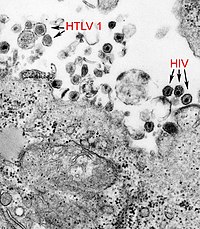
Photo from wikipedia
Human T-lymphotropic virus 1 (HTLV-1) is an important human pathogen. A fair estimate indicates that at least 5–10 million people harbor the virus worldwide (Legrand et al., 2022), and more… Click to show full abstract
Human T-lymphotropic virus 1 (HTLV-1) is an important human pathogen. A fair estimate indicates that at least 5–10 million people harbor the virus worldwide (Legrand et al., 2022), and more recently the World Health Organization (WHO) was called upon (Martin et al., 2018) to respond positively to establish adequate public health policies toward its elimination (World Health Organization, 2021). This virus is associated with a large array of diseases, including lymphoma/leukemia, neurodegenerative diseases, uveitis, infective dermatitis, Sjogren’s syndrome, bronchiectasis, bronchitis and bronchiolitis, rheumatoid arthritis, arthritis, kidney and bladder infections, dermatophytosis, community acquired pneumonia, Strongyloides hyperinfection syndrome, tuberculosis, liver cancer, lymphoma other than adult T-cell leukemia-lymphoma and cervical cancer (Schierhout et al., 2020). Human T-lymphotropic virus 2 (HTLV-2) is still not conclusively etiologically linked to a disease although a number of disease associations have been reported particularly from the HOST study (Araújo and Hall, 2004; Orland et al., 2004; Martinez et al., 2019). Two other types, Human T-lymphotropic virus 3 (HTLV-3) and Human T-lymphotropic virus 4 (HTLV-4) have been described in a forest area in Cameroon (Wolfe et al., 2005) as result of cross-species transmission, with their occurrence restricted to this geographic area, without evidence of pathogenicity and human-to-human transmission (Duong et al., 2008; Perzova et al., 2010). HTLV-1 and HTLV-2 share molecular properties, including the evolutionary aspect of viral and cell nucleic acid integration, silent and lifelong persistence and transmission pathways (Hall et al., 1996; Ciminale et al., 2014; Martinez et al., 2019) and are classified into the family Retroviridae, subfamily Orthoretrovirinae, genus Deltaretrovirus, which has four species: Bovine Leukemia virus and Primate T-lymphotropic viruses (PTLV) 1, 2, and 3 (ICTV—ICTV International Commitee on Taxonomy of Viruses, 2022). Within PTLV-1, 2 and 3, ICTV includes three types of human retroviruses, HTLV-1, HTLV-2, and HTLV-3, respectively. HTLV-4 remains a related but unclassified virus.
Journal Title: Frontiers in Microbiology
Year Published: 2022
Link to full text (if available)
Share on Social Media: Sign Up to like & get
recommendations!